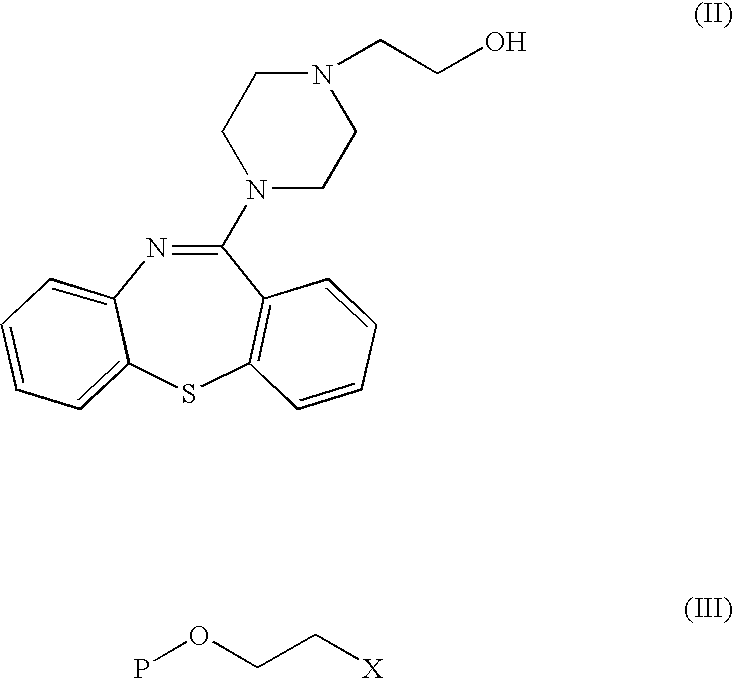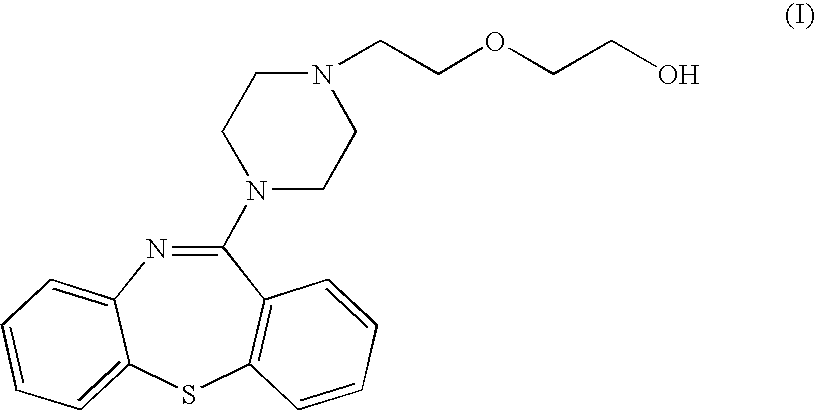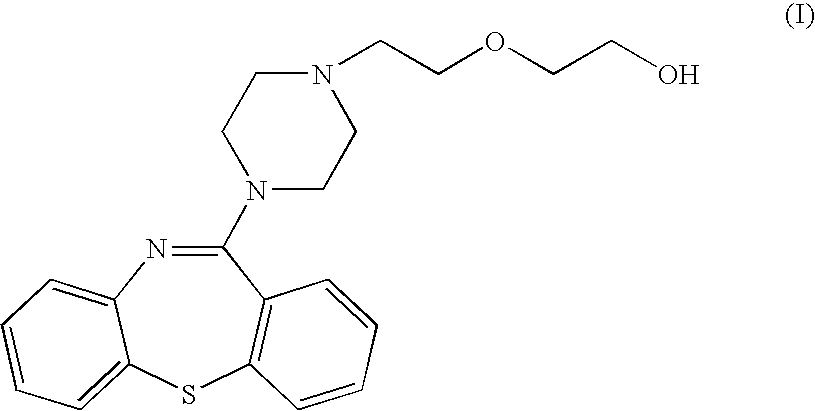Procedure for preparing a pharmaceutically active compound
a technology of pharmaceutical active compounds and preparation procedures, which is applied in the field of preparation procedures of pharmaceutically active compounds, can solve the problems of large residual aqueous products, inability to obtain base quetiapine in crystalline form,
- Summary
- Abstract
- Description
- Claims
- Application Information
AI Technical Summary
Problems solved by technology
Method used
Image
Examples
examples of synthesis
Example 1
11-(4-[2-(2-hydroxyethoxy)ethyl]-1-piperazinyl)dibenzo[b,f][1,4]thiazepine (base Quetiapine)
[0035] To 26.2 mL of 50% aqueous solution of sodium hydroxide are added successively 5 g (14.7 mmols) de 2-(4-dibenzo[b,f][1,4]thiazepine-11-il-piperazine-1-il)ethanol, 10.43 g (63.4 mmols) of 2-(2-chloroethoxy)-tetrahydro-2H-pyrane and 0.49 g of tetrabutyl ammonium hydrogen sulphate. The mixture is heated at 60° C. for 6 hours with thorough stirring. It is cooled to 20-25° C., and 45 mL de toluene and 26 mL of water are added while agitating. The phases are separated and the organic phase is washed with water (2×26 mL). 32 mL of water and 5 mL of 35% hydrochloric acid 35% are added and the two-phase mixture is stirred at 20-25° C. for 3 hours. The phases are separated and the aqueous phase is washed successively with n-butanol (10 mL) and toluene (10 mL). Then 45 mL of toluene and 10% aqueous solution of potassium carbonate are added until the aqueous phase pH 10 is reached. The p...
example 2
11-(4-[2-(2-hydroxyethoxy)ethyl]-1-piperazinyl)dibenzo[b,f][1,4]thiazepine (base Quetiapine)
[0038] To 10.43 g (63.4 mmols) of 2-(2-chloroethoxy)-tetrahydro-2H-pyrane are added successively 5 g (14.7 mmols) of 2-(4-dibenzo[b,f][1.4]thiazepine-11-il-piperazine-1-il)ethanol, 5 g of powdered potassium hydroxide and 0.49 g 18-corona-6 catalyst. The mixture is heated at 40° C. for 6 hours with thorough stirring. The synthesis proceeds as in Example 1, yielding 4.65 g (82%) of the product of the title as a light yellow oil, having IR and 1H-RMN spectra identical to those of the product obtained in Example 1.
example 3
11-(4-[2-(2-hydroxyethoxy)ethyl]-1-piperazinyl)dibenzo[b,f][1,4]thiazepine (base Quetiapine)
[0039] To 10.43 g (63.4 mmols) of 2-(2-chloroethoxy)-tetrahydro-2H-pyrane are added successively 5 g (14.7 mmols) of 2-(4-dibenzo[b,f][1.4]thiazepine-11-il-piperazine-1-il)ethanol, 5 g of powdered potassium hydroxide and 0.49 g of Aliquat 336 catalyst. The mixture is heated at 40° C. for 20 hours with thorough stirring. The synthesis proceeds as in Example 1, yielding 4.23 g (75%) of the product of the title as a light yellow oil, having IR and 1H-RMN spectra identical to those of the product obtained in Example 1.
PUM
| Property | Measurement | Unit |
|---|---|---|
| Temperature | aaaaa | aaaaa |
| Phase | aaaaa | aaaaa |
| Purity | aaaaa | aaaaa |
Abstract
Description
Claims
Application Information
 Login to View More
Login to View More - R&D
- Intellectual Property
- Life Sciences
- Materials
- Tech Scout
- Unparalleled Data Quality
- Higher Quality Content
- 60% Fewer Hallucinations
Browse by: Latest US Patents, China's latest patents, Technical Efficacy Thesaurus, Application Domain, Technology Topic, Popular Technical Reports.
© 2025 PatSnap. All rights reserved.Legal|Privacy policy|Modern Slavery Act Transparency Statement|Sitemap|About US| Contact US: help@patsnap.com



